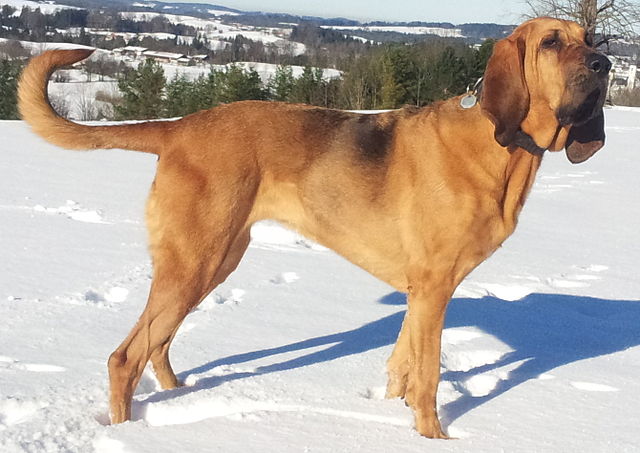


The Bloodhound is a large, distinctive hound breed known for its remarkable scenting ability and exceptional tracking skills. Originally bred for hunting, the Bloodhound is most famous for its ability to track scents over long distances and find missing persons or fugitives. This breed has a calm and gentle demeanor, making it a friendly companion, though its primary role remains in scent detection. Bloodhounds are often used in search-and-rescue operations, law enforcement, and tracking dogs due to their unparalleled olfactory sense.
The Bloodhound’s history dates back to medieval times in Europe. It is believed to have been developed by monks at the Saint-Hubert Monastery in Belgium, where they were originally bred as hunting dogs. The breed’s name comes from “blood,” meaning “noble,” referring to its noble origins. Bloodhounds were initially used to track deer, wild boar, and other large game. Over time, their incredible tracking ability made them valuable in law enforcement and search-and-rescue operations. Today, Bloodhounds are still regarded as the gold standard in scent tracking and are frequently employed by police and rescue teams around the world.
The Bloodhound is a large, muscular dog with a distinctive appearance, characterized by its long, droopy ears, wrinkled skin, and deep-set eyes. Males typically weigh between 90 to 110 pounds, and females range from 80 to 100 pounds. They stand about 23 to 27 inches tall at the shoulder. Their coat is short, dense, and weather-resistant, usually in colors like black and tan, liver and tan, or red. The breed has a long, narrow head with a prominent nose that helps it excel at scent detection. Their ears are particularly long and floppy, and their skin is loose and wrinkled, particularly around the face and neck.
The Bloodhound is known for its calm, friendly, and patient temperament. They are generally affectionate with their family and good with children, making them excellent family pets. Despite their large size, Bloodhounds are typically gentle and tolerant of other animals. While they are typically not aggressive, they do have an independent streak, especially when following a scent trail, and may become distracted when on a hunt. Early training and socialization are important to ensure they are well-mannered, as their strong prey drive and tracking instincts can lead to them following scents and wandering off if not properly managed.
While the Bloodhound is not as energetic as some other working breeds, it still requires regular exercise to maintain good health. This breed has high stamina and enjoys long walks, hikes, and exploring outdoors, especially in environments where it can use its tracking abilities. A securely fenced yard is ideal, as Bloodhounds have a strong sense of smell and may follow a trail if given the opportunity. Daily physical and mental stimulation, such as scent-based games or obedience training, is essential to keep them engaged and prevent boredom. Due to their tracking instinct, Bloodhounds require supervision when outdoors to prevent them from becoming fixated on an intriguing scent.
The Bloodhound is an intelligent breed, but they can be independent and stubborn, making training a challenge for novice owners. They are motivated by their strong scenting instincts, and while they are generally responsive to positive reinforcement techniques, they may become distracted when following a trail. Bloodhounds thrive in environments that engage their natural instincts, such as scent games or tracking exercises. Early socialization is important to ensure that they are comfortable with people, other animals, and various situations. Consistent, positive training methods, along with a lot of patience, are necessary to help them learn proper manners and obedience.
The Bloodhound is generally a healthy breed, but like all dogs, they are prone to certain health issues. Some common conditions in the breed include hip dysplasia, ear infections, and eye conditions such as entropion (a condition where the eyelids roll inward). The breed’s long ears require regular cleaning to prevent infections. Bloodhounds also have a tendency to gain weight, so proper diet management is essential to avoid obesity. Their short coat requires minimal grooming, but their skin folds and ears should be checked regularly for dirt and moisture buildup. Regular veterinary visits are important to keep them healthy and to detect any potential issues early.
The average lifespan of a Bloodhound is typically between 10 to 12 years. With proper care, including a healthy diet, regular exercise, and routine veterinary visits, some Bloodhounds may live longer. Like all breeds, their lifespan can be affected by genetic factors, and some health conditions may develop as they age. Keeping them active, maintaining a healthy weight, and attending regular check-ups are all important steps to ensure they live a long and fulfilling life.
© copyright Dog Compendium 2024 - 2025